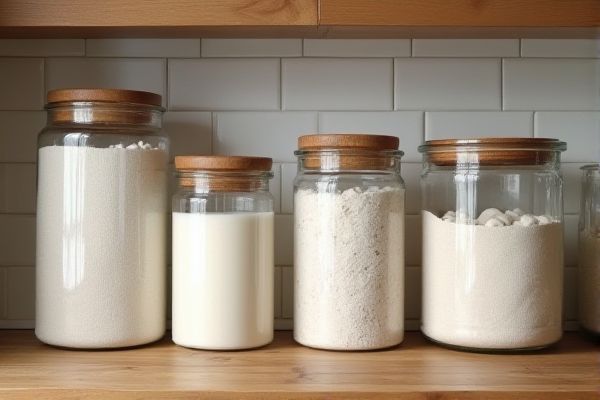
Flour sack bins provide a breathable storage option that helps prevent moisture buildup, while airtight canisters create a sealed environment that protects against pests and preserves freshness longer. Explore the rest of the article to determine which storage solution suits your kitchen needs best.
Table of Comparison
| Feature | Flour Sack Bins | Airtight Canisters |
|---|---|---|
| Material | Plastic or metal with open tops | BPA-free plastic, glass, or metal with airtight seals |
| Seal Quality | Loose or no seal, allows air exposure | Strong airtight seal, prevents moisture and pests |
| Storage Duration | Short to medium term (weeks to months) | Long term (months to years) |
| Moisture Protection | Poor | Excellent |
| Pest Resistance | Low | High |
| Capacity | Large, suited for bulk storage | Varies from small to medium, less suited for bulk |
| Ease of Access | Easy to scoop but less neat | Easy to pour or scoop, usually neater |
| Cleaning | Simple, wide openings | Removable lids, some harder to clean |
| Cost | Generally lower | Generally higher |
Introduction: Flour Storage Solutions Compared
Flour sack bins provide breathable storage that helps maintain flour freshness by preventing moisture buildup, making them ideal for short-term use in kitchens with moderate humidity. Airtight canisters offer a sealed environment that protects flour from pests, humidity, and contaminants, extending shelf life significantly for long-term storage. Choosing between these options depends on factors like storage duration, kitchen climate, and flour quantity.
What Are Flour Sack Bins?
Flour sack bins are large, breathable containers designed specifically for storing bulk quantities of flour, allowing airflow to prevent moisture buildup and clumping. Unlike airtight canisters, which seal tightly to keep out air and pests, flour sack bins often feature wide openings and fabric covers to maintain the flour's freshness while providing easy access. These bins are ideal for home bakers who use flour frequently and need practical storage that balances protection with usability.
Understanding Airtight Canisters
Airtight canisters provide superior protection against moisture, pests, and air exposure, preserving flour's freshness significantly longer than traditional flour sack bins. Typically made from materials like BPA-free plastic, glass, or stainless steel, airtight canisters create a sealed environment that prevents clumping and spoilage. Choosing airtight canisters for flour storage ensures optimal quality retention, extending shelf life and reducing food waste.
Material and Design Differences
Flour sack bins are typically made from breathable fabric or mesh materials that allow air circulation, helping to prevent moisture buildup and mildew. Airtight canisters, on the other hand, are constructed from durable materials like BPA-free plastic, stainless steel, or glass, featuring tight-sealing lids designed to lock out air and preserve freshness longer. The design of flour sack bins emphasizes flexibility and ventilation, while airtight canisters prioritize complete air exclusion and moisture protection.
Moisture Protection: Which Is Superior?
Airtight canisters provide superior moisture protection compared to flour sack bins by creating a sealed environment that prevents humidity and external moisture from entering. Flour sack bins, typically made from breathable fabric, allow some air circulation, which can lead to moisture absorption and spoilage over time. For preserving the freshness and quality of your flour, airtight canisters are the best choice to ensure maximum moisture protection.
Freshness and Shelf Life Considerations
Flour sack bins offer breathable storage allowing slight airflow, which helps prevent moisture buildup but may shorten flour's shelf life compared to airtight canisters that create a sealed environment blocking oxygen and humidity. Airtight canisters effectively maintain flour's freshness by slowing oxidation and protecting against contaminants, extending shelf life significantly. Your choice depends on whether you prioritize natural moisture control or maximum preservation for long-term storage.
Ease of Use and Accessibility
Flour sack bins offer easy access with wide openings and stackable designs that simplify storage and retrieval, making them ideal for frequent use. Airtight canisters provide secure sealing to preserve freshness but often require more effort to open and close, which can slow down access during busy cooking sessions. Users seeking quick and convenient access typically prefer flour sack bins, while airtight canisters prioritize durability and freshness retention.
Capacity and Space Efficiency
Flour sack bins typically offer larger capacities ranging from 5 to 10 pounds, making them ideal for bulk storage, while airtight canisters usually hold between 1 to 5 pounds, optimizing portion control. Flour sack bins are designed to stack compactly, saving countertop or pantry space, whereas airtight canisters often feature slim, modular designs that fit seamlessly in tight spaces. Choosing between the two depends on balancing the need for volume versus minimizing storage footprint in a kitchen setting.
Cleaning and Maintenance Requirements
Flour sack bins are typically easier to clean due to their simple design and often fewer crevices where flour can accumulate, requiring only occasional washing and drying. Airtight canisters, while excellent for preserving freshness, demand more thorough cleaning to prevent residue buildup in seals and lids that can harbor moisture or mold. To maintain optimal hygiene and extend the lifespan of your storage, regularly inspect and clean both containers, with particular attention to airtight seals to avoid contamination.
Final Verdict: Choosing the Right Flour Storage Option
Flour sack bins offer breathable storage that helps prevent moisture buildup and clumping, ideal for dry, cool environments, while airtight canisters provide superior protection from pests and humidity, extending flour freshness for longer durations. Selecting the right flour storage depends on kitchen conditions and flour usage frequency, with airtight containers favored for high-moisture areas or infrequent use. For optimal flour preservation, consider material quality, seal integrity, and storage environment when choosing between flour sack bins and airtight canisters.
 homyna.com
homyna.com